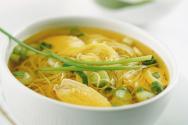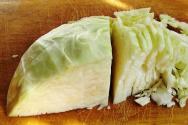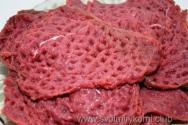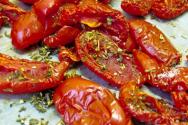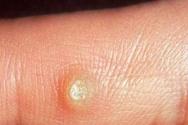Puffer fish liver. Japanese fugu fish: fish dishes, cooking technology and causes of poisoning. Chef training and licensing
Poisonous pufferfish (dogfish, pufferfish, diodont or fahak) - a legend Japanese cuisine- an object of horror, curiosity and admiration for foreigners. This most famous, expensive and dangerous dish of Japanese cuisine is rightfully considered one of the oldest.
Judging by the finds of archaeologists, even before our era, the Japanese ate the poisonous fugu fish, apparently knowing that the poison was contained only in certain parts of its body.
The liver, milt, caviar, intestines, eyes and skin of puffer fish contain a deadly natural nerve poison - tetrodotoxin. This poison is superior in its effect to both the famous curare and cyanide. One fish contains enough poison to kill 30-40 people. There is still no effective antidote for fugu poisoning.
Meanwhile, in microscopic proportions, fugu poison is considered an excellent means of preventing age-related diseases and even, according to rumors, a cure for prostate diseases. Therefore, the poisonous fugu fins (fried on a grill until charred) are dipped in sake for one or two minutes. This healing drink in individually dosed form is served before meals to clients who want to taste fugu. The cook acts as an anesthesiologist, assessing the complexion and health status of each guest. They say that intoxication from such an infusion feels akin to a drug: all senses are heightened, the ability to see, hear and touch much more than usual appears.
fugu dish
Cutting a pufferfish is a filigree art. With quick blows of the knife, the cook separates the fins, cuts off the mouthparts and opens the belly of the puffer. The poisonous parts are carefully removed from the abdomen. The fillet must be cut into thin pieces (no thicker than paper) and washed thoroughly under running water, removing the slightest traces of blood and poison.
 |
Fugu is also served in the form of “ set lunch" In this case, fugusashi is only the beginning of the meal. In addition to this, “fugu-zosui” is served - a soup made from the broth of boiled fugu fish, rice and raw egg, as well as lightly fried puffer fish.
Pieces of fugu fish are served by the cook in a strictly defined order. They start from the back - the most delicious and least poisonous. The pieces are served in order of proximity to the peritoneum. The closer to it, the stronger the poison. The cook's duty is to vigilantly monitor the condition of the guests, not allowing them to eat more than the dose that is safe for them. The trick when preparing puffer fish is to leave just enough poison to give the eater a feeling of mild narcotic euphoria. Gourmets who have tried fugu fish claim that as this dish is consumed, a paralyzing wave rolls over the eater: first the legs are taken away, then the arms, then the jaws. Only the eyes retain the ability to move. However, after a moment everything comes to life in reverse order: the gift of speech returns, arms and legs begin to move. They say that it is for this moment of “resurrection” that people take mortal risks.
Pufferfish is prepared and served only in Japan. According to statistics collected since the 19th century, from 1886 to 1979. More than 12.5 thousand people suffered from fugu poison, more than half of whom (almost 7 thousand) died. True, it is not known whether the cooks are also included in the number of victims: after all, it is believed that in the event of the death of a client, a cook must commit hara-kiri to himself. However, they claim that most of the poisonings occurred due to non-professionals (for example, among fishermen who decided to feast on a dangerous catch). In 1980, Japan's Ministry of Health introduced mandatory licensing for chefs to cut and serve fugu. Today, approximately 70 thousand people in Japan have such diplomas. The number of victims among gourmets has decreased to two dozen per year, and only a few die from this dish. However, since fugu is a very expensive dish, rich and famous people become its victims. Each such death is a loud scandal.
Not long ago, extremely proud scientists announced that they had created a non-poisonous puffer fish. It turns out that the secret was in the natural diet of the fish. Fugu does not produce poison in its own body: it becomes toxic by eating poisonous starfish and shellfish. If a pufferfish is placed on a non-poisonous diet from birth, the tetrodotoxin content in the fish will be zero. However, the expected sensation and flow of gratitude to scientific thought did not happen. After all, without its toxin, the puffer fish becomes just another type of fish - quite tasty, but not anything special. The secret of the popularity of fugu lies precisely in its toxicity, in the acute sense of risk that a person experiences when playing this gastronomic version of Russian roulette. It’s not for nothing that it is in the spring (when fugu fish is considered the most poisonous) that gourmets pay the highest price for it - up to $700 per kg. The Japanese say that “he who eats fugu is a fool, but so is he who does not eat it.” Dying from fugu poison is a worthy death by Japanese standards.
Emelyanova Ekaterina
The poisonous fugu fish (dogfish, pufferfish, diodont or fahak) is a legend of Japanese cuisine and an object of horror, curiosity and admiration for foreigners.
The poisonous fugu fish (dogfish, pufferfish, diodont or fahak) is a legend of Japanese cuisine and an object of horror, curiosity and admiration for foreigners. This most famous, expensive and dangerous dish of Japanese cuisine is rightfully considered one of the oldest. Judging by the finds of archaeologists, even before our era, the Japanese ate the poisonous fugu fish, apparently knowing that the poison was contained only in certain parts of its body.
The liver, milt, caviar, intestines, eyes and skin of puffer fish contain a deadly natural nerve poison - tetrodotoxin. This poison is superior in its effect to both the famous curare and cyanide. One fish contains enough poison to kill 30-40 people. There is still no effective antidote for fugu poisoning.
Meanwhile, in microscopic proportions, fugu poison is considered an excellent means of preventing age-related diseases and even, according to rumors, a cure for prostate diseases. Therefore, the poisonous fugu fins (fried on a grill until charred) are dipped in sake for one or two minutes. This healing drink in individually dosed form is served before meals to clients who want to taste fugu. The cook acts as an anesthesiologist, assessing the complexion and health status of each guest. They say that intoxication from such an infusion feels akin to a drug: all senses are heightened, the ability to see, hear and touch much more than usual appears.
Cutting a pufferfish is a filigree art. With quick blows of the knife, the cook separates the fins, cuts off the mouthparts and opens the belly of the puffer. The poisonous parts are carefully removed from the abdomen. The fillet must be cut into thin pieces (no thicker than paper) and washed thoroughly under running water, removing the slightest traces of blood and poison.
“Fugusashi” (fugu sashimi) is a very special taste and very beautiful dish. Mother-of-pearl slices of raw fugu are arranged like petals on a round dish. Often the cook creates a picture from pieces of fish: a landscape, an image of a butterfly or a flying bird. The fish is eaten by dipping the slices in a mixture of ponzu (vinegar sauce), asatsuki (chopped chives), momiji-oroshi (grated daikon radish) and red pepper.
Fugu is also served as a “set lunch”. In this case, fugusashi is only the beginning of the meal. In addition to this, “fugu-zosui” is served - a soup made from a broth of boiled fugu fish, rice and raw egg, as well as lightly fried fugu fish.
Pieces of fugu fish are served by the cook in a strictly defined order. They start from the back - the most delicious and least poisonous. The pieces are served in order of proximity to the peritoneum. The closer to it, the stronger the poison. The cook's duty is to vigilantly monitor the condition of the guests, not allowing them to eat more than the dose that is safe for them. The trick when preparing puffer fish is to leave just enough poison to give the eater a feeling of mild narcotic euphoria. Gourmets who have tried fugu fish claim that as this dish is consumed, a paralyzing wave rolls over the eater: first the legs are taken away, then the arms, then the jaws. Only the eyes retain the ability to move. However, after a moment everything comes to life in reverse order: the gift of speech returns, arms and legs begin to move. They say that it is for this moment of “resurrection” that people take mortal risks.
Pufferfish is prepared and served only in Japan. According to statistics collected since the 19th century, from 1886 to 1979. More than 12.5 thousand people suffered from fugu poison, more than half of whom (almost 7 thousand) died. True, it is not known whether the cooks are also included in the number of victims: after all, it is believed that in the event of the death of a client, a cook must commit hara-kiri to himself. However, they claim that most of the poisonings occurred due to non-professionals (for example, among fishermen who decided to feast on a dangerous catch). In 1980, Japan's Ministry of Health introduced mandatory licensing for chefs to cut and serve fugu. Today, approximately 70 thousand people in Japan have such diplomas. The number of victims among gourmets has decreased to two dozen per year, and only a few die from this dish. However, since fugu is a very expensive dish, rich and famous people become its victims. Each such death is a loud scandal.
Not long ago, extremely proud scientists announced that they had created a non-poisonous puffer fish. It turns out that the secret was in the natural diet of the fish. Fugu does not produce poison in its own body: it becomes toxic by eating poisonous starfish and shellfish. If a pufferfish is placed on a non-poisonous diet from birth, the tetrodotoxin content in the fish will be zero. However, the expected sensation and flow of gratitude to scientific thought did not happen. After all, without its toxin, the puffer fish becomes just another type of fish - quite tasty, but not anything special. The secret of the popularity of fugu lies precisely in its toxicity, in the acute sense of risk that a person experiences when playing this gastronomic version of Russian roulette. It is not for nothing that it is in the spring (when fugu fish is considered the most poisonous) that gourmets pay the highest price for it - up to 0 per kg. The Japanese say that “he who eats fugu is a fool, but so is he who does not eat it.” Dying from fugu poison is a worthy death by Japanese standards.
Fugu is a small fish, only about the size of your palm, that can swim tail first. Instead of scales, it has thin, elastic skin. If the fugu is frightened, it will instantly swell and take the shape of a ball studded with sharp spines. In this state, it is three times its original size. This happens due to the water that the fish abruptly sucks into itself. The deadly poison - tetrodotoxin - is found in the milk, caviar, genitals, skin and liver of fugu. This substance has a nerve-paralytic effect. It is approximately 1200 times more dangerous than potassium cyanide. The lethal dose for humans is just one milligram of tetrodotoxin. One fish contains enough of this substance to kill forty people. Moreover, an effective antidote still does not exist. In microscopic portions, fugu venom is used as a means of preventing age-related diseases and as a cure for prostate diseases. Here is one of the ancient recipes for preparing a healing drink based on pufferfish - the poisonous fins of the fish are first fried until charred, and then dipped in sake for two minutes. They say that the intoxication from such an infusion is very specific and resembles a narcotic dope with accompanying hallucinations and aggravation of all senses. By the way, sake prepared in this way is required to be served to customers who want to taste fugu. It is believed that this ritual gives, albeit a small, but still a chance to survive in case of poisoning.
Lunch in the name of death
The owner of a restaurant that aspires to have fugu dishes on its menu is required to provide detailed reports to the sanitary inspectors of the Ministry of Health on the quantity and storage conditions of stocks of this fish in his establishment. Cutting a pufferfish is a unique art that takes a long time to learn, and only a few master it. Back in 1598, a law appeared obliging a cook who wants to cook this fish to obtain a state license. In order to enter the circle of the elite, you must pass two exams - written and practical. Approximately three-quarters of applicants are eliminated in the first test, which requires an understanding of dozens of varieties of fugu and knowledge of all detoxification methods. And during the final exam, the candidate must eat what he himself prepared.
It is not surprising that prices for such delicacies range from $100 to $500 per serving. One of the most famous dishes from fugu - fugusashi. Mother of pearl slices raw fish placed in petals on a round dish. Often the chef creates a real picture from the pieces: landscapes with butterflies or a flying bird. The fish is eaten by dipping the slices in a mixture of ponzu (vinegar sauce), asatsuki (crushed chives), momiji-oroshi (grated daikon radish) and red pepper. As a rule, customers who come to specialty restaurants order only fugu. The meal begins with fugusashi, followed by fugu-zosui - a soup made from pufferfish broth decorated with rice and a raw egg, as well as lightly fried slices of the same fish. The fugu pieces are served by the chef in a strictly defined order. They start from the back - the most delicious and least poisonous, then approach the peritoneum - the place of the main accumulation of poison. The cook's duty is to vigilantly monitor the condition of the guests, not allowing them to eat more than a safe dose. To do this, it is necessary not only to know the intricacies of preparing this dish, but also to have medical knowledge, since the intensity of the effects of the poison depends on the client’s build, temperament and even skin color.
The most famous death from fugu occurred in 1975. Legendary kabuki actor Mitsugoro Bando the Eighth, who was called a "living national treasure", died of paralysis after eating fugu liver in a Kyoto restaurant. This was his fourth attempt to try the dangerous dish.
Who needs this?
The most important mystery of fugu is why people take mortal risks. Fans of extreme cuisine claim that the taste of pufferfish is reminiscent of Japanese silk paintings - something refined, elusive and smooth. Kitaoji Rosannin, the creator of the delightful pottery, wrote: “The taste of this fish cannot be compared with anything. If you eat fugu three or four times, you will become a slave to fugu. Anyone who refuses this dish for fear of dying deserves deep sympathy.” In addition to its incredible taste, fugu is believed to have a narcotic effect. The trick when preparing pufferfish is to leave just enough poison to give the eater a feeling of mild euphoria. Gourmets who have tried this fish claim that as the dish is consumed, a paralyzing wave rolls in: first the legs are taken away, then the arms, then the jaws. Only the eyes retain the ability to move. However, after a moment everything comes to life: the power of speech returns, arms and legs begin to move. Related to this is the third reason why the Japanese love fugu so much. It's all about a special attitude towards death. The samurai also believed that passing away from life is the apotheosis of beauty. Fugu allows you to touch the Japanese understanding of perfection and, with a successful combination of circumstances, return back. Not long ago, extremely proud scientists announced that they had bred a non-poisonous pufferfish.
It turns out that the secret was in the natural diet of the fish. Fugu does not produce toxic substances in its own body - it becomes toxic by eating poisonous starfish and shellfish. If you put a puffer fish on a diet from birth, you will get a completely safe inhabitant of the deep sea. However, the expected sensation did not happen. After all, without its toxin, the puffer fish becomes just another type of fish - quite tasty, but not anything special. It is not for nothing that it is in the spring, when fugu is considered the most poisonous, that gourmets pay the highest price.
Puffer fish poisoning occurs when eating improperly prepared poisonous four-toothed fish, namely one of the varieties of puffer fish or the so-called dog fish. There are more than 100 species of pufferfish inhabiting subtropical and tropical waters that wash the coasts of continents and islands: the Atlantic, Pacific and Indian oceans, and the Sea of Japan. To prepare fugu, an exquisite and dangerous dish of Japanese cuisine, several species of pufferfish are usually used, including the brown pufferfish.
1 The essence of the question
Fugu is a small fish (on average 40 cm), which has no scales and is capable of inflating like a ball studded with sharp spines in a moment of danger. Tetrodotoxin is a deadly poison, which is found in large quantities in the liver, caviar, intestines and skin of fish, affects the central nervous system of the poisoned person and causes paralysis of the muscles and respiratory organs. appear quite quickly (within 10-15 minutes). First, there is numbness of the tongue and lips, then the sensitivity of the limbs is lost, and coordination of movements is impaired. Inability to swallow and dizziness in more serious cases can result in vomiting and breathing problems.
Puffer fish poisoning can be fatal if the dose of poison is large enough. In this case, paralysis of the central nervous system and respiratory organs develops within half an hour. The victim can be saved only by connecting an artificial respiration apparatus to him and maintaining circulatory functions. But at the same time, it cannot be said with confidence that a person will survive and not fall into a coma. There is no antidote to tetrodotoxin yet.
A person who has an idea of the possible consequences of such a delicacy and decides to taste such an exotic delicacy must have a philosophical attitude towards life. Apparently, the Japanese are okay with this, since they have such a traditional and extreme dish. What is the appeal of fugu that makes so many culinary gourmets take mortal risks? Experts say that tender fillet The fish melts in your mouth and tastes like Japanese painting: something subtle and elusive. But most likely it’s about the thrill associated with mortal risk. The well-known Japanese attitude towards death resonates with fearless hearts. In addition, tetrodotoxin in small doses left by a virtuoso cook acts as a drug, intoxicating, analgesic, heightening all senses and breaking the connection with reality.
2 Preparing the delicacy
The process of preparing fugu is a whole ritual, which is strictly described step by step and is performed only by a professional licensed chef who can distinguish edible fugu fish from extremely dangerous ones. Removing poisonous parts of fish requires special skill and knowledge in this area, so not every cook can obtain the right to cook fugu. Even touching the poisonous insides of puffer fish is believed to pose a health risk. After removing the poisonous parts and skin, the fillet is cut and washed in running water.
The fillet is cut so thin that it shines through, and the chef creates various figures or landscapes on a plate from these mother-of-pearl petals. This dish is made from raw slices fugu, called fugusashi, is served with a special ponzu sauce and momiji-oroshi (a mixture of grated radish and red pepper). Next comes fugu-zosui soup and lightly fried fugu slices. All dishes are served directly by the chef, who carefully monitors that guests do not eat more than a safe dose.
Price exotic delicacy ranges from $40 for 1 tasting to $500 for a 5-course menu. Not every Japanese or guest visiting the Land of the Rising Sun can afford extreme gastronomy experiences at such prices.
Currently, non-toxic fugu fish is being bred in several countries. The fact is that the strongest toxin in the body of the pufferfish accumulates in the process of eating poisonous mollusks, worms and starfish. Changing the diet of fish makes it safe and quite edible, but completely boring and ordinary. Therefore, the breeding of this type of puffer fish did not cause any particular sensation.
3 Medical use
From the centuries-old history of Japan and China, recipes are known that include fugu fish. Such drugs were used as painkillers and prescribed for the treatment of leprosy, mental disorders, heart disease and prostate disease.
The mechanism of action of tetrodotoxin on nervous tissue is of deep scientific interest to many scientists conducting research in this area. Due to its ability to selectively block the transmission of nerve impulses, tetrodotoxin can be used as an anesthetic. In the future, it is planned to widely use it to create highly effective anesthetics, as well as in the treatment of patients with rheumatism, arthritis, neuralgia and many other diseases.
Fugu dishes are a traditional Japanese delicacy, a piece of the cultural heritage of the ancient inhabitants of the Land of the Rising Sun. It is known that even before the advent of our era, this fish, deadly for humans, was eaten in Japan.
The poisonousness of dishes made from these fish was first reported to Europeans by the famous navigator D. Cook, who with his companions had the imprudence to try fugu at one of the native feasts, after which he was seriously ill for several days: “... we felt an unprecedented weakness in all members, accompanied by such a feeling as if arms and legs, numb in the cold, had immediately fallen into fire..."
The danger of fugu lies in the strongest poison - tetrodotoxin, which is present in the internal organs, liver, caviar, milk and on the skin of this fish. Tetrodotoxin is a nerve poison, which in its toxicity is almost one and a half thousand times more dangerous than potassium cyanide, and its amount in the body of an adult puffer fish is enough to kill several dozen people.
What kind of fish is this, and why has the deadly dish made from its flesh been so attractive to the Japanese for many hundreds of years? However, not only the Japanese - in recent years, numerous tourists from European countries visiting Japan, Korea, China or Thailand, where fugu dish is included in the menu of many restaurants, have also sought to try this famous delicacy. In Europe, cooking fugu is prohibited due to the high risk of poisoning, so fans of the “adrenaline tsunami” are trying to make up for lost opportunities in Asian countries.
Fugu ("fugu fish") is a fish of the pufferfish family ( Tetraodontidae). Other names for representatives of this family are often used: pufferfish, dogfish, four-toothed, rock-toothed, rock-toothed. The family is very large - it contains 26 genera, uniting almost two hundred species.
Pufferfish are found not only in the sea - some species have mastered brackish and desalinated waters, and even fresh water of rivers, for living. So, fahak (Tetraodon fahaka) found in the Nile and some lakes in Africa, mbu (Tetraodon mbu) - in the Congo. Freshwater puffers are found in the rivers of the West Indies and South America (Amazon). The largest of the pufferfish representatives is the Stellatus species (Arothron stellatus), reaching a length of 120 cm, lives in the Indo-Pacific.
Most representatives of the pufferfish family have an oval-rounded body covered with smooth skin without scales. Usually the skin is covered with spines, which normally adhere to its surface. The head is large, the mouth is small. These fish are called four-toothed because of the characteristic plates formed by fused jaws and resembling four teeth in shape.
It is curious that the developed pectoral fins of the puffer allow them to swim even with their tail first. These fish do not have ventral (pelvic) fins.
Despite their seemingly defenseless smooth skin, pufferfish are not the favorite prey of predators - they are capable of not only protecting themselves, but even killing an enemy. The unique ability to swallow air and water into special outgrowths of the stomach allows the fugu to instantly turn its body into a ball studded with spines. And if a predator tries to swallow this bristling ball, it risks choking on the prey stuck in the throat or esophagus and dying.
Most rocktooths are omnivorous fish - they feed on both plant and animal prey.

To prepare the famous Japanese delicacy, the most commonly used type is Takifugu rubripes- brown puffer (brown rocktooth, brown dog-fish, ocellated dog-fish). This fish reaches 80 cm in length, the average size- 35-40 cm.
Brown puffer is found in marine and brackish waters in the northwest Pacific Ocean - from the southern regions of the Sea of Okhotsk to the East China Sea. It is found in the Far Eastern seas of Russia - the Sea of Okhotsk and the Sea of Japan.
It reproduces by laying eggs. Juveniles of the brown rocktooth prefer to stay at shallow (up to 100 m) depths, not moving far from the shore; they are often found even in brackish river mouths. Adult brown puffers prefer to stay away from the coast.
The external distinctive feature of these fish is the presence of a black round spot in the area of the pectoral fins, behind the head, which is surrounded by a narrow light border. On the dorsal part of the body and sides there are also light dots, sometimes intricate patterns of light lines. The brown puffer does not have pelvic fins, like all rock-toothed fish.
This fish serves as the basis for the preparation of the famous and notoriously dangerous dish called “fugu fish.” Every year, several dozen people become victims of improper preparation of this dish, however, there are no fewer people wanting to try this deadly delicacy.
Since 1958, Japanese chefs have been allowed to prepare dishes from rock teeth only after completing special courses, passing an exam and obtaining the appropriate license. Cooks are trained not only in ways to remove poison from the body of fugu - they must understand the taxonomy of these fish, i.e. be able to distinguish different types rocktoothed. During the exam, the cook who prepared the dangerous dish must eat it himself.
It is curious that the pinnacle of a chef’s skill is not considered to be the ability to completely remove poison from fish, but to leave it just enough so that after eating the dish the visitor experiences some effect of the toxin, similar to the effect of drugs, which is one of the advantages of this delicacy. According to gourmet fugufans, it is the presence of a certain amount of toxins in fish meat that gives dishes made from it an exquisite piquancy.
Eating “fugu fish” is also a kind of ritual. Most often, fugu is served in the form of several individual dishes in which fish is cooked different ways(boiled, lightly fried or served with special sauce). The chef’s task is not only to serve dishes in strict order, but also to vigilantly monitor the condition of clients in order to prevent exceeding the permissible dose of poison when eating. Everything is taken into account - the client’s build, his age, his external state of health, and even his nationality. After all, if a client gets poisoned, according to tradition, the cook must make himself hara-kiri, which was a common occurrence in the recent Japanese past.  Some of the most popular fugu dishes include fugusashi (fugu slices with a delicious sauce) and fugu-zosui (fugu soup).
Some of the most popular fugu dishes include fugusashi (fugu slices with a delicious sauce) and fugu-zosui (fugu soup).
Is fugu really so delicious that people risk losing their lives to taste it? This mystery is considered to be not fully solved.
There are several versions of the unprecedented popularity of the dish.
According to some, the mortal danger of the dish attracted and continues to attract samurai, as the most famous fans of playing with death. Others believe that the whole point is the narcotic effect of fugu poison on the body of the person eating the dish. Still others claim that the dish really has most delicate taste and attracts with its sophistication. In addition to these, the most commonly used arguments, there is an opinion that fugu meat has a number of healing and miraculous properties.
It has now been established that fugu fry do not have poison in their bodies - it accumulates in the process of eating poisonous food - mollusks, starfish and some other marine life. Using special technology, fish hatcheries even raise “safe” rocktooths, which can be eaten without fear of poisoning. From early childhood, these fish are fed only with special food that prevents the accumulation of poison in the body. It is curious that the lucky ones who managed to try the “safe” fugu fish note its quite ordinary taste.
Apparently, the reason for the Japanese craving for eating squids does not lie in the uniqueness of the meat of these fish - it is the toxins that give fugu dishes a special charm, color and uniqueness of the delicacy.
If you are eager to taste this gastronomic celebrity, get ready for significant financial expenses - in restaurants the cost of a serving of “fugu fish” can reach up to a hundred or more “greenbacks”. Well, we don’t recommend cooking fish yourself, even for enemies - death from poisoning occurs in a couple of minutes, and an effective antidote has not yet been found.
Articles
